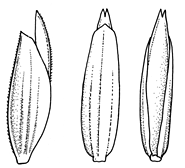Common name: Reed Sweetgrass
Glyceria maxima (Hartm.) Holmb. APNI* 
Description: Stout rhizomatous perennial to 2.5 m high; culms to 12 mm diam., hollow, ribbed, glabrous, sometimes glands in a ring below node.
Leaves with sheath closed, ribbed, glabrous; ligule membranous, 4–7 mm long, apiculate; blade flat, to 16 mm wide, subulate, ribbed, midrib prominent, scabrous.
Inflorescence open, 25–30 cm long, to 15 cm wide. Spikelets to 1 cm long, 4–9 florets; pedicels to 15 mm long, ribbed, glabrous, sometimes scabrous. Glumes obtuse, membranous, 1-nerved; lower c. 2 mm long, upper c. 3 mm long. Lemmas 2–3 mm long, obtuse, overlapping, 7-nerved, keeled, keel scabrous. Palea marginally longer than lemma, 2-keeled, keels scabrous.
Flowering: spring–summer.
Distribution and occurrence: Planted in swampy areas as a fodder crop but has become a significant weed of wetlands. Native of Eur.
NSW subdivisions: *NC, *CC, *SC, *NT, *CT, *ST, *CWS, *SWS, *NWP, *SWP
Other Australian states: *Qld *Vic. *Tas.
Text by S. W. L. Jacobs & K. L. McClay
Taxon concept: Flora of NSW 4 (1993)
APNI* Provides a link to the Australian Plant Name Index (hosted by the Australian National Botanic Gardens) for comprehensive bibliographic data
***The AVH map option provides a detailed interactive Australia wide distribution map drawn from collections held by all major Australian herbaria participating in the Australian Virtual Herbarium project.
|


